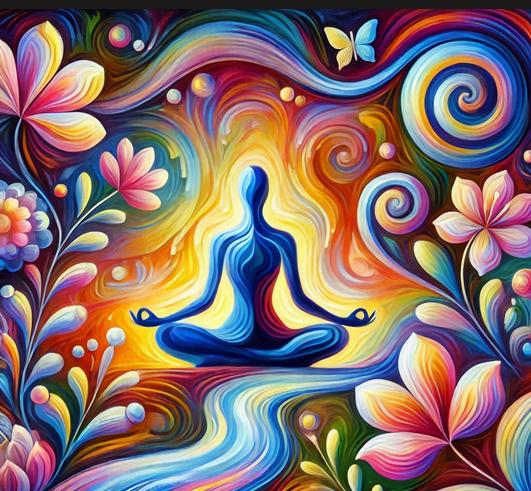Healing Through Breath: Mystical Breathing Practices for Inner Peace
Breath is the very essence of life. It is the rhythm that sustains our existence, the force that connects body, mind, and spirit. In many mystical and spiritual traditions, breath is not merely a biological function but a bridge between the physical and the divine. The ancient practices of pranayama (in yoga), the breathwork of indigenous cultures, and the teachings of mystics throughout history all emphasize the profound power of breath to heal, calm, and awaken the spirit.
As a practitioner of mysticism, I have witnessed firsthand the transformative power of conscious breathing. Breath is a direct link to the present moment, and through mindful breathing, we can access a deeper level of awareness, healing, and connection with our higher self. Breathing is a tool that can help us navigate the stresses and challenges of modern life while also opening the door to spiritual awakening.
In this essay, I will share several mystical breathing techniques that have been passed down through spiritual traditions and offer simple, practical ways to incorporate them into your daily life. These practices can help you achieve inner peace, healing, and a deeper sense of spiritual connection.
1. The Power of Breath: A Bridge Between Body and Spirit
Breath is often overlooked as a tool for healing and spiritual awakening. However, in many ancient spiritual traditions, it is seen as sacred, a direct connection to the divine energy that flows through all life. In the yogic tradition, the word “prana” refers to the vital life force or energy that is carried through the breath. Similarly, in Taoism, “qi” (or “chi”) represents the life energy that flows through the body, which can be cultivated and balanced through breathing practices.
When we breathe consciously, we do more than just take in air; we activate the flow of prana or qi within us. Mystical breathing practices are designed to harmonize this energy, bringing balance, healing, and spiritual insight. Through these practices, we can learn to quiet the mind, release stored emotions, and open ourselves to the deeper currents of wisdom and grace that are always available to us.
Breath is also deeply connected to our emotional and mental states. In times of stress, fear, or anxiety, our breath becomes shallow and rapid, signaling the body’s fight-or-flight response. On the other hand, when we are relaxed and at peace, our breath flows naturally, slowly, and deeply. By consciously working with the breath, we can influence our physical and emotional states, creating a sense of peace and calm in the midst of life’s challenges.
2. The Mystical Significance of Breath
In mystical traditions, breath has always been seen as a symbol of the divine presence. In the Bible, the Hebrew word “ruach” and the Greek word “pneuma” both mean “spirit” or “breath.” The concept of breath as spirit is a universal theme that appears across cultures and religions. In many mystical teachings, the act of breathing is a form of communion with the divine—every breath we take is an opportunity to connect with the sacred energy that animates all life.
The mystic’s relationship with breath is not limited to the physical process of inhalation and exhalation; it is seen as a spiritual practice that helps open the mind and heart to higher states of consciousness. In various mystical schools, breath is used to quiet the chatter of the mind, to clear blocked emotions, and to tap into a deeper sense of inner peace and spiritual awakening.
One of the key principles of mystical breathing practices is that breath is the channel through which we can access the subtle energy of the universe. When we breathe consciously, we invite the flow of divine energy into our being, aligning ourselves with higher consciousness and opening ourselves to healing and transformation.
3. Breathing as a Tool for Relaxation and Healing
In modern society, many of us are disconnected from the power of our breath. We rush through life, often taking shallow, irregular breaths that leave us feeling stressed and drained. Reconnecting with the breath is one of the simplest and most powerful ways to bring relaxation and healing into our lives.
The following mystical breathing techniques can be used to release stress, promote relaxation, and support emotional and physical healing. These practices can be done anywhere and at any time, making them accessible tools for creating peace and balance in your daily life.
4. 1. The Conscious Breath: Cultivating Present-Moment Awareness
The most fundamental and accessible mystical breathing practice is the conscious breath. The conscious breath is simply the act of bringing your full attention to your breathing. By focusing on the breath, you anchor yourself in the present moment, letting go of the distractions of the past and future. This practice is the foundation of many other mystical breathing techniques.
How to Practice:
- Find a quiet space where you can sit comfortably, with your spine straight and your body relaxed.
- Close your eyes and begin to take a few deep breaths, inhaling through your nose and exhaling through your mouth. Allow the breath to be smooth and relaxed.
- Now, begin to breathe naturally, without forcing or controlling the breath. Simply observe the inhalations and exhalations as they come and go.
- As you breathe, bring your full attention to the sensations of the breath. Feel the coolness of the air as it enters your nostrils, and the warmth as it leaves. Notice the rise and fall of your chest or abdomen with each breath.
- If your mind begins to wander, gently bring your attention back to the breath. Do not judge yourself for distractions—simply return to the present moment with each inhale and exhale.
This simple yet powerful practice of conscious breathing helps cultivate a state of mindfulness and presence, allowing you to connect with your inner self and experience a deeper sense of peace.
5. 2. Pranayama: The Yogic Breath of Life
Pranayama is the ancient yogic practice of controlling the breath to influence the flow of prana (life force) in the body. It is considered one of the most powerful tools for spiritual awakening and healing. Pranayama techniques involve specific patterns of inhalation, retention, and exhalation, designed to balance the flow of energy and bring harmony to the body and mind.
One of the most common and effective pranayama techniques is Nadi Shodhana, or Alternate Nostril Breathing. This technique is known for its ability to calm the mind, balance the left and right hemispheres of the brain, and purify the energy channels in the body.
How to Practice Nadi Shodhana:
- Sit in a comfortable seated position with your spine straight and your body relaxed. Rest your left hand on your knee and bring your right hand to your face.
- Close your right nostril with your right thumb, and inhale deeply through your left nostril.
- At the top of the inhale, close your left nostril with your right ring finger, and exhale slowly and completely through your right nostril.
- Inhale deeply through the right nostril, then close the right nostril and exhale through the left nostril.
- This completes one cycle. Continue for 5-10 minutes, focusing on the flow of breath and the balance between the left and right sides of the body and mind.
Nadi Shodhana helps calm the nervous system, clear mental fog, and promote emotional balance. It is especially beneficial for those experiencing anxiety, stress, or mental fatigue.
6. 3. The Healing Breath: Breath of Light
In many mystical traditions, breath is seen as a conduit for spiritual energy. The Breath of Light is a visualization technique that combines deep breathing with the intention of healing and spiritual awakening. In this practice, the breath is imagined as a healing light that flows through the body, clearing away blockages and bringing peace and vitality.
How to Practice the Breath of Light:
- Sit or lie down in a quiet space, ensuring your body is relaxed and your mind is calm.
- Begin by taking a few deep breaths, inhaling through your nose and exhaling through your mouth. Allow your body to relax with each breath.
- Now, imagine that with each inhale, you are drawing in light—a bright, healing light. Visualize this light entering your body through the crown of your head.
- As you exhale, imagine this light flowing down through your body, washing away any tension, negative energy, or emotional blockages.
- Continue breathing in this healing light, visualizing it flowing throughout your body, particularly to areas where you may feel pain, discomfort, or emotional tension.
- Spend 10-15 minutes with this practice, feeling the light cleanse and heal every part of you.
The Breath of Light is a powerful way to release negative energy, heal emotional wounds, and align your physical body with higher spiritual frequencies.
7. 4. The Heart Breath: Connecting with Divine Love
The Heart Breath is a mystical breathing technique that involves focusing on the heart center, or the Anahata Chakra, and breathing into the feeling of love and compassion. This practice helps open the heart, release emotional blockages, and connect with divine love.
How to Practice the Heart Breath:
- Sit comfortably with your hands resting on your heart, feeling the warmth of your palms on your chest.
- Close your eyes and begin to take slow, deep breaths, focusing on the sensation of the breath as it enters and leaves your body.
- As you inhale, imagine drawing in love and compassion from the universe. Visualize this love filling your heart and expanding throughout your entire being.
- As you exhale, release any tension, fear, or emotional heaviness. Imagine this negative energy leaving your body with each breath.
- Continue this practice for 10-15 minutes, allowing yourself to feel the love and peace that comes with each inhale and exhale.
The Heart Breath is an incredibly powerful practice for emotional healing, opening the heart, and connecting with divine love. It is especially helpful for those who feel disconnected or emotionally blocked.
8. Conclusion: The Mystical Power of Breath
Breath is one of the most accessible and powerful tools we have for healing and spiritual awakening. Through conscious breathing, we can release stress, calm the mind, heal emotional wounds, and connect with our higher selves. The mystical breathing practices shared here are just a few of the many techniques that have been passed down through spiritual traditions to help us tap into the transformative power of the breath.
As you practice these breathing techniques, remember that each breath is an opportunity to return to the present moment, to align with your highest self, and to connect with the divine energy that flows through all of life. By making conscious breathwork a part of your daily life, you can experience greater peace, healing, and spiritual awakening.
May the breath guide you toward deeper understanding, greater peace, and the inner wisdom that





